HLT54115 Diploma of Nursing: Case Study on Mr. McFarlane's Care Plan
VerifiedAdded on 2023/06/18
|11
|2774
|194
Case Study
AI Summary
This case study response template focuses on the care of Mr. McFarlane, addressing a sudden decline in his condition. Initially, the response details the immediate nursing actions taken upon discovering Mr. McFarlane in distress, emphasizing the importance of rapid assessment, care management, and communication with medical staff. It includes rationales for each action, supported by references. The analysis extends to documenting and interpreting vital signs, employing the ABCDEFGH approach to systematically evaluate the patient's condition. Furthermore, the response outlines an ISBAR handover to the Emergency Team, ensuring clear and concise communication of critical patient information. The case study also involves revising Mr. McFarlane's care plan, incorporating new nursing diagnoses and interventions, and emphasizing the role of a multidisciplinary team. Finally, the response includes a progress note documenting the event, nursing assessments, interventions, and the evaluation of care provided, aligning with the NMBA Enrolled Nurse Standards for Practice. Desklib offers a wealth of similar solved assignments and past papers to aid students in their studies.
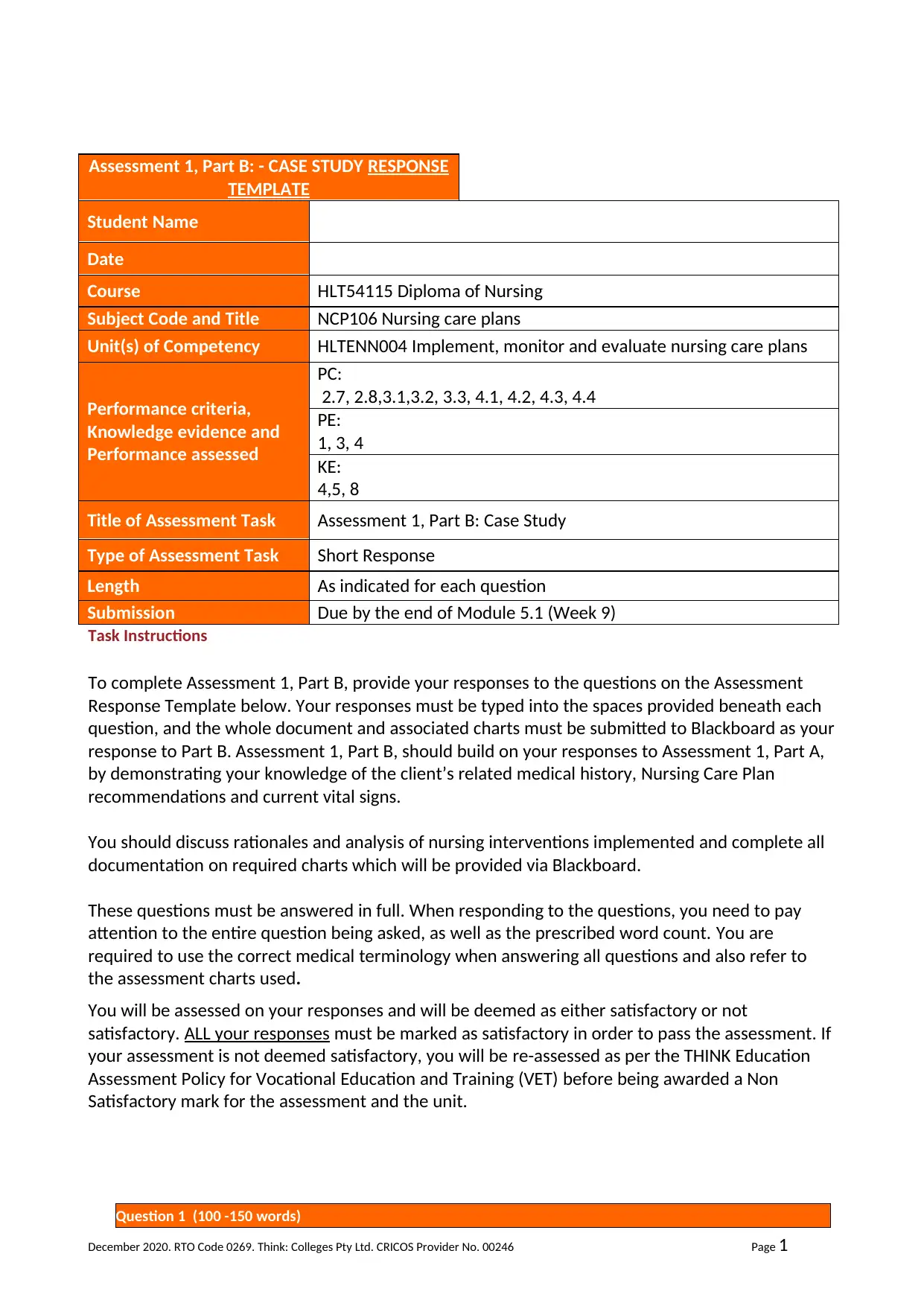
Assessment 1, Part B: - CASE STUDY RESPONSE
TEMPLATE
Student Name
Date
Course HLT54115 Diploma of Nursing
Subject Code and Title NCP106 Nursing care plans
Unit(s) of Competency HLTENN004 Implement, monitor and evaluate nursing care plans
Performance criteria,
Knowledge evidence and
Performance assessed
PC:
2.7, 2.8,3.1,3.2, 3.3, 4.1, 4.2, 4.3, 4.4
PE:
1, 3, 4
KE:
4,5, 8
Title of Assessment Task Assessment 1, Part B: Case Study
Type of Assessment Task Short Response
Length As indicated for each question
Submission Due by the end of Module 5.1 (Week 9)
Task Instructions
To complete Assessment 1, Part B, provide your responses to the questions on the Assessment
Response Template below. Your responses must be typed into the spaces provided beneath each
question, and the whole document and associated charts must be submitted to Blackboard as your
response to Part B. Assessment 1, Part B, should build on your responses to Assessment 1, Part A,
by demonstrating your knowledge of the client’s related medical history, Nursing Care Plan
recommendations and current vital signs.
You should discuss rationales and analysis of nursing interventions implemented and complete all
documentation on required charts which will be provided via Blackboard.
These questions must be answered in full. When responding to the questions, you need to pay
attention to the entire question being asked, as well as the prescribed word count. You are
required to use the correct medical terminology when answering all questions and also refer to
the assessment charts used.
You will be assessed on your responses and will be deemed as either satisfactory or not
satisfactory. ALL your responses must be marked as satisfactory in order to pass the assessment. If
your assessment is not deemed satisfactory, you will be re-assessed as per the THINK Education
Assessment Policy for Vocational Education and Training (VET) before being awarded a Non
Satisfactory mark for the assessment and the unit.
Question 1 (100 -150 words)
December 2020. RTO Code 0269. Think: Colleges Pty Ltd. CRICOS Provider No. 00246 Page 1
TEMPLATE
Student Name
Date
Course HLT54115 Diploma of Nursing
Subject Code and Title NCP106 Nursing care plans
Unit(s) of Competency HLTENN004 Implement, monitor and evaluate nursing care plans
Performance criteria,
Knowledge evidence and
Performance assessed
PC:
2.7, 2.8,3.1,3.2, 3.3, 4.1, 4.2, 4.3, 4.4
PE:
1, 3, 4
KE:
4,5, 8
Title of Assessment Task Assessment 1, Part B: Case Study
Type of Assessment Task Short Response
Length As indicated for each question
Submission Due by the end of Module 5.1 (Week 9)
Task Instructions
To complete Assessment 1, Part B, provide your responses to the questions on the Assessment
Response Template below. Your responses must be typed into the spaces provided beneath each
question, and the whole document and associated charts must be submitted to Blackboard as your
response to Part B. Assessment 1, Part B, should build on your responses to Assessment 1, Part A,
by demonstrating your knowledge of the client’s related medical history, Nursing Care Plan
recommendations and current vital signs.
You should discuss rationales and analysis of nursing interventions implemented and complete all
documentation on required charts which will be provided via Blackboard.
These questions must be answered in full. When responding to the questions, you need to pay
attention to the entire question being asked, as well as the prescribed word count. You are
required to use the correct medical terminology when answering all questions and also refer to
the assessment charts used.
You will be assessed on your responses and will be deemed as either satisfactory or not
satisfactory. ALL your responses must be marked as satisfactory in order to pass the assessment. If
your assessment is not deemed satisfactory, you will be re-assessed as per the THINK Education
Assessment Policy for Vocational Education and Training (VET) before being awarded a Non
Satisfactory mark for the assessment and the unit.
Question 1 (100 -150 words)
December 2020. RTO Code 0269. Think: Colleges Pty Ltd. CRICOS Provider No. 00246 Page 1
Paraphrase This Document
Need a fresh take? Get an instant paraphrase of this document with our AI Paraphraser
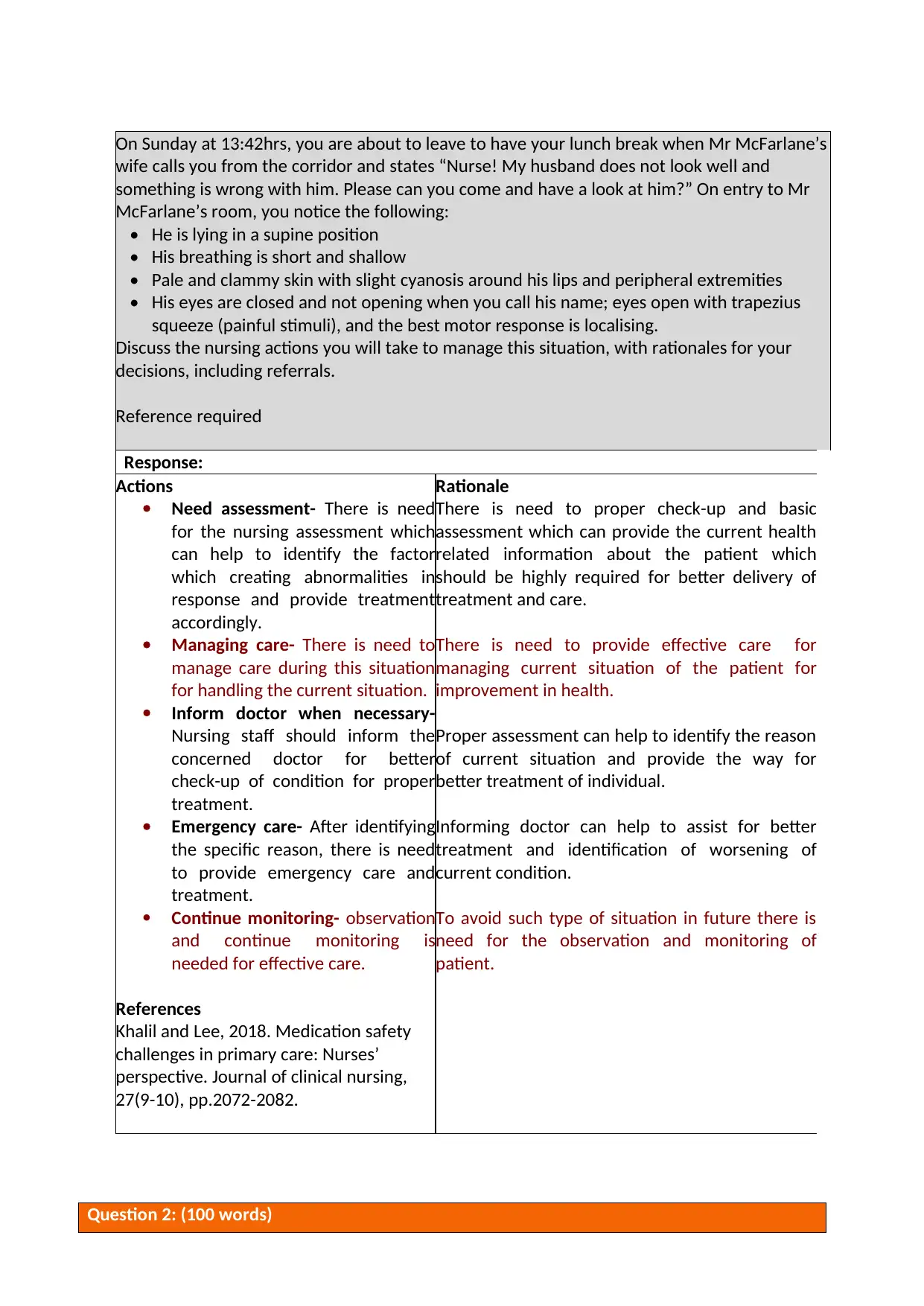
On Sunday at 13:42hrs, you are about to leave to have your lunch break when Mr McFarlane’s
wife calls you from the corridor and states “Nurse! My husband does not look well and
something is wrong with him. Please can you come and have a look at him?” On entry to Mr
McFarlane’s room, you notice the following:
• He is lying in a supine position
• His breathing is short and shallow
• Pale and clammy skin with slight cyanosis around his lips and peripheral extremities
• His eyes are closed and not opening when you call his name; eyes open with trapezius
squeeze (painful stimuli), and the best motor response is localising.
Discuss the nursing actions you will take to manage this situation, with rationales for your
decisions, including referrals.
Reference required
Response:
Actions
Need assessment- There is need
for the nursing assessment which
can help to identify the factor
which creating abnormalities in
response and provide treatment
accordingly.
Managing care- There is need to
manage care during this situation
for handling the current situation.
Inform doctor when necessary-
Nursing staff should inform the
concerned doctor for better
check-up of condition for proper
treatment.
Emergency care- After identifying
the specific reason, there is need
to provide emergency care and
treatment.
Continue monitoring- observation
and continue monitoring is
needed for effective care.
References
Khalil and Lee, 2018. Medication safety
challenges in primary care: Nurses’
perspective. Journal of clinical nursing,
27(9-10), pp.2072-2082.
Rationale
There is need to proper check-up and basic
assessment which can provide the current health
related information about the patient which
should be highly required for better delivery of
treatment and care.
There is need to provide effective care for
managing current situation of the patient for
improvement in health.
Proper assessment can help to identify the reason
of current situation and provide the way for
better treatment of individual.
Informing doctor can help to assist for better
treatment and identification of worsening of
current condition.
To avoid such type of situation in future there is
need for the observation and monitoring of
patient.
Question 2: (100 words)
wife calls you from the corridor and states “Nurse! My husband does not look well and
something is wrong with him. Please can you come and have a look at him?” On entry to Mr
McFarlane’s room, you notice the following:
• He is lying in a supine position
• His breathing is short and shallow
• Pale and clammy skin with slight cyanosis around his lips and peripheral extremities
• His eyes are closed and not opening when you call his name; eyes open with trapezius
squeeze (painful stimuli), and the best motor response is localising.
Discuss the nursing actions you will take to manage this situation, with rationales for your
decisions, including referrals.
Reference required
Response:
Actions
Need assessment- There is need
for the nursing assessment which
can help to identify the factor
which creating abnormalities in
response and provide treatment
accordingly.
Managing care- There is need to
manage care during this situation
for handling the current situation.
Inform doctor when necessary-
Nursing staff should inform the
concerned doctor for better
check-up of condition for proper
treatment.
Emergency care- After identifying
the specific reason, there is need
to provide emergency care and
treatment.
Continue monitoring- observation
and continue monitoring is
needed for effective care.
References
Khalil and Lee, 2018. Medication safety
challenges in primary care: Nurses’
perspective. Journal of clinical nursing,
27(9-10), pp.2072-2082.
Rationale
There is need to proper check-up and basic
assessment which can provide the current health
related information about the patient which
should be highly required for better delivery of
treatment and care.
There is need to provide effective care for
managing current situation of the patient for
improvement in health.
Proper assessment can help to identify the reason
of current situation and provide the way for
better treatment of individual.
Informing doctor can help to assist for better
treatment and identification of worsening of
current condition.
To avoid such type of situation in future there is
need for the observation and monitoring of
patient.
Question 2: (100 words)
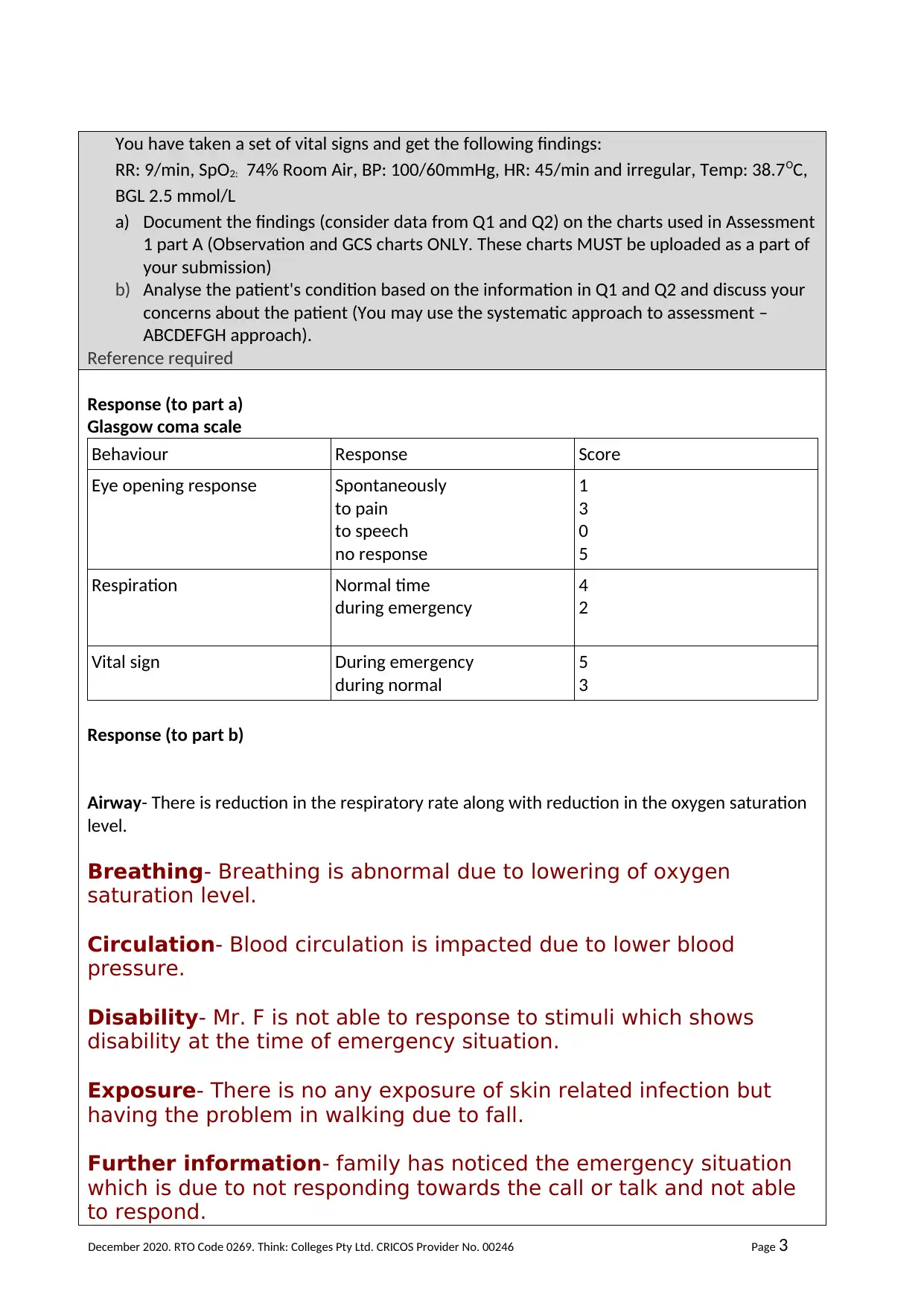
You have taken a set of vital signs and get the following findings:
RR: 9/min, SpO2: 74% Room Air, BP: 100/60mmHg, HR: 45/min and irregular, Temp: 38.7OC,
BGL 2.5 mmol/L
a) Document the findings (consider data from Q1 and Q2) on the charts used in Assessment
1 part A (Observation and GCS charts ONLY. These charts MUST be uploaded as a part of
your submission)
b) Analyse the patient's condition based on the information in Q1 and Q2 and discuss your
concerns about the patient (You may use the systematic approach to assessment –
ABCDEFGH approach).
Reference required
Response (to part a)
Glasgow coma scale
Behaviour Response Score
Eye opening response Spontaneously
to pain
to speech
no response
1
3
0
5
Respiration Normal time
during emergency
4
2
Vital sign During emergency
during normal
5
3
Response (to part b)
Airway- There is reduction in the respiratory rate along with reduction in the oxygen saturation
level.
Breathing- Breathing is abnormal due to lowering of oxygen
saturation level.
Circulation- Blood circulation is impacted due to lower blood
pressure.
Disability- Mr. F is not able to response to stimuli which shows
disability at the time of emergency situation.
Exposure- There is no any exposure of skin related infection but
having the problem in walking due to fall.
Further information- family has noticed the emergency situation
which is due to not responding towards the call or talk and not able
to respond.
December 2020. RTO Code 0269. Think: Colleges Pty Ltd. CRICOS Provider No. 00246 Page 3
RR: 9/min, SpO2: 74% Room Air, BP: 100/60mmHg, HR: 45/min and irregular, Temp: 38.7OC,
BGL 2.5 mmol/L
a) Document the findings (consider data from Q1 and Q2) on the charts used in Assessment
1 part A (Observation and GCS charts ONLY. These charts MUST be uploaded as a part of
your submission)
b) Analyse the patient's condition based on the information in Q1 and Q2 and discuss your
concerns about the patient (You may use the systematic approach to assessment –
ABCDEFGH approach).
Reference required
Response (to part a)
Glasgow coma scale
Behaviour Response Score
Eye opening response Spontaneously
to pain
to speech
no response
1
3
0
5
Respiration Normal time
during emergency
4
2
Vital sign During emergency
during normal
5
3
Response (to part b)
Airway- There is reduction in the respiratory rate along with reduction in the oxygen saturation
level.
Breathing- Breathing is abnormal due to lowering of oxygen
saturation level.
Circulation- Blood circulation is impacted due to lower blood
pressure.
Disability- Mr. F is not able to response to stimuli which shows
disability at the time of emergency situation.
Exposure- There is no any exposure of skin related infection but
having the problem in walking due to fall.
Further information- family has noticed the emergency situation
which is due to not responding towards the call or talk and not able
to respond.
December 2020. RTO Code 0269. Think: Colleges Pty Ltd. CRICOS Provider No. 00246 Page 3
⊘ This is a preview!⊘
Do you want full access?
Subscribe today to unlock all pages.

Trusted by 1+ million students worldwide
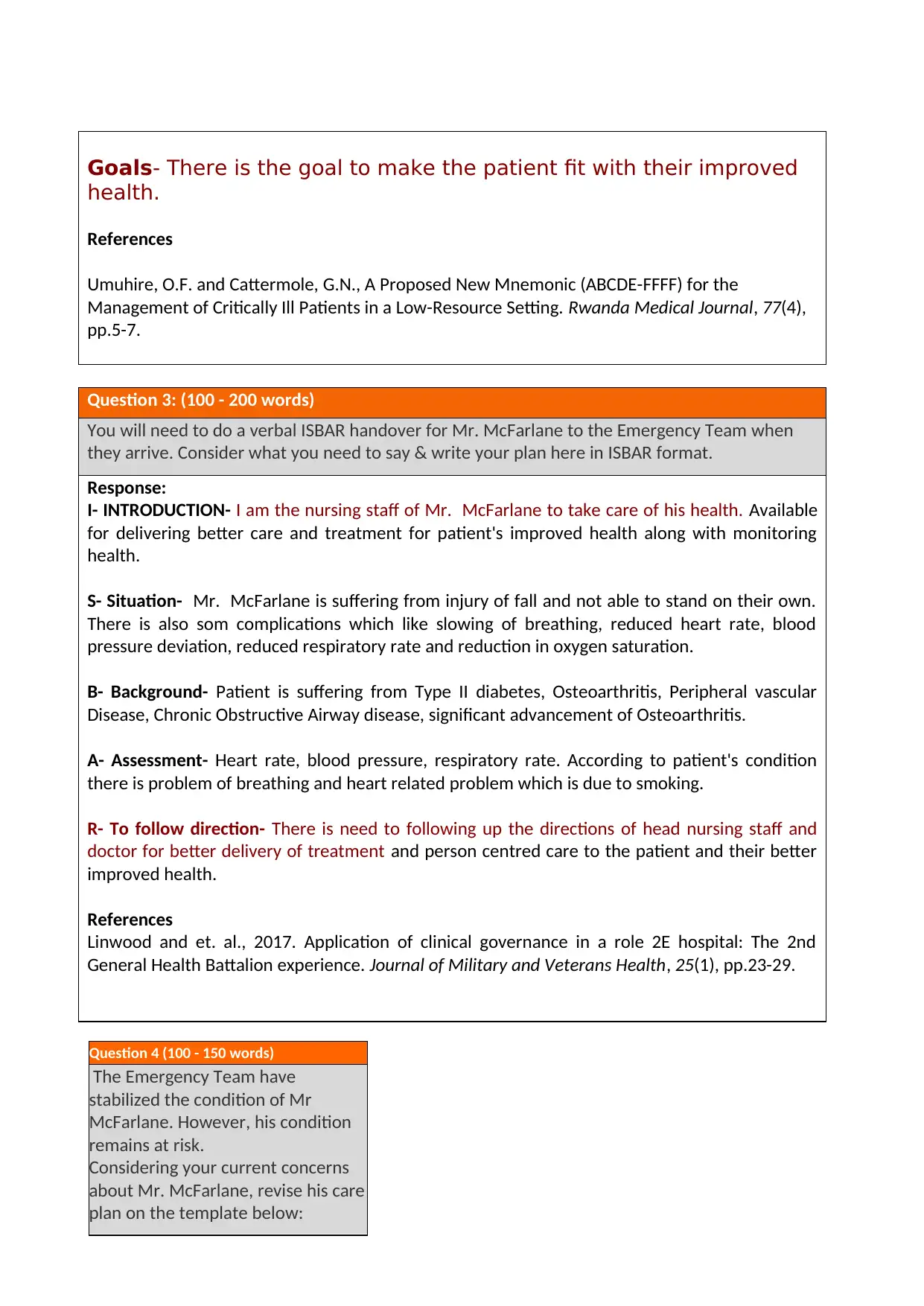
Goals- There is the goal to make the patient fit with their improved
health.
References
Umuhire, O.F. and Cattermole, G.N., A Proposed New Mnemonic (ABCDE-FFFF) for the
Management of Critically Ill Patients in a Low-Resource Setting. Rwanda Medical Journal, 77(4),
pp.5-7.
Question 3: (100 - 200 words)
You will need to do a verbal ISBAR handover for Mr. McFarlane to the Emergency Team when
they arrive. Consider what you need to say & write your plan here in ISBAR format.
Response:
I- INTRODUCTION- I am the nursing staff of Mr. McFarlane to take care of his health. Available
for delivering better care and treatment for patient's improved health along with monitoring
health.
S- Situation- Mr. McFarlane is suffering from injury of fall and not able to stand on their own.
There is also som complications which like slowing of breathing, reduced heart rate, blood
pressure deviation, reduced respiratory rate and reduction in oxygen saturation.
B- Background- Patient is suffering from Type II diabetes, Osteoarthritis, Peripheral vascular
Disease, Chronic Obstructive Airway disease, significant advancement of Osteoarthritis.
A- Assessment- Heart rate, blood pressure, respiratory rate. According to patient's condition
there is problem of breathing and heart related problem which is due to smoking.
R- To follow direction- There is need to following up the directions of head nursing staff and
doctor for better delivery of treatment and person centred care to the patient and their better
improved health.
References
Linwood and et. al., 2017. Application of clinical governance in a role 2E hospital: The 2nd
General Health Battalion experience. Journal of Military and Veterans Health, 25(1), pp.23-29.
Question 4 (100 - 150 words)
The Emergency Team have
stabilized the condition of Mr
McFarlane. However, his condition
remains at risk.
Considering your current concerns
about Mr. McFarlane, revise his care
plan on the template below:
health.
References
Umuhire, O.F. and Cattermole, G.N., A Proposed New Mnemonic (ABCDE-FFFF) for the
Management of Critically Ill Patients in a Low-Resource Setting. Rwanda Medical Journal, 77(4),
pp.5-7.
Question 3: (100 - 200 words)
You will need to do a verbal ISBAR handover for Mr. McFarlane to the Emergency Team when
they arrive. Consider what you need to say & write your plan here in ISBAR format.
Response:
I- INTRODUCTION- I am the nursing staff of Mr. McFarlane to take care of his health. Available
for delivering better care and treatment for patient's improved health along with monitoring
health.
S- Situation- Mr. McFarlane is suffering from injury of fall and not able to stand on their own.
There is also som complications which like slowing of breathing, reduced heart rate, blood
pressure deviation, reduced respiratory rate and reduction in oxygen saturation.
B- Background- Patient is suffering from Type II diabetes, Osteoarthritis, Peripheral vascular
Disease, Chronic Obstructive Airway disease, significant advancement of Osteoarthritis.
A- Assessment- Heart rate, blood pressure, respiratory rate. According to patient's condition
there is problem of breathing and heart related problem which is due to smoking.
R- To follow direction- There is need to following up the directions of head nursing staff and
doctor for better delivery of treatment and person centred care to the patient and their better
improved health.
References
Linwood and et. al., 2017. Application of clinical governance in a role 2E hospital: The 2nd
General Health Battalion experience. Journal of Military and Veterans Health, 25(1), pp.23-29.
Question 4 (100 - 150 words)
The Emergency Team have
stabilized the condition of Mr
McFarlane. However, his condition
remains at risk.
Considering your current concerns
about Mr. McFarlane, revise his care
plan on the template below:
Paraphrase This Document
Need a fresh take? Get an instant paraphrase of this document with our AI Paraphraser
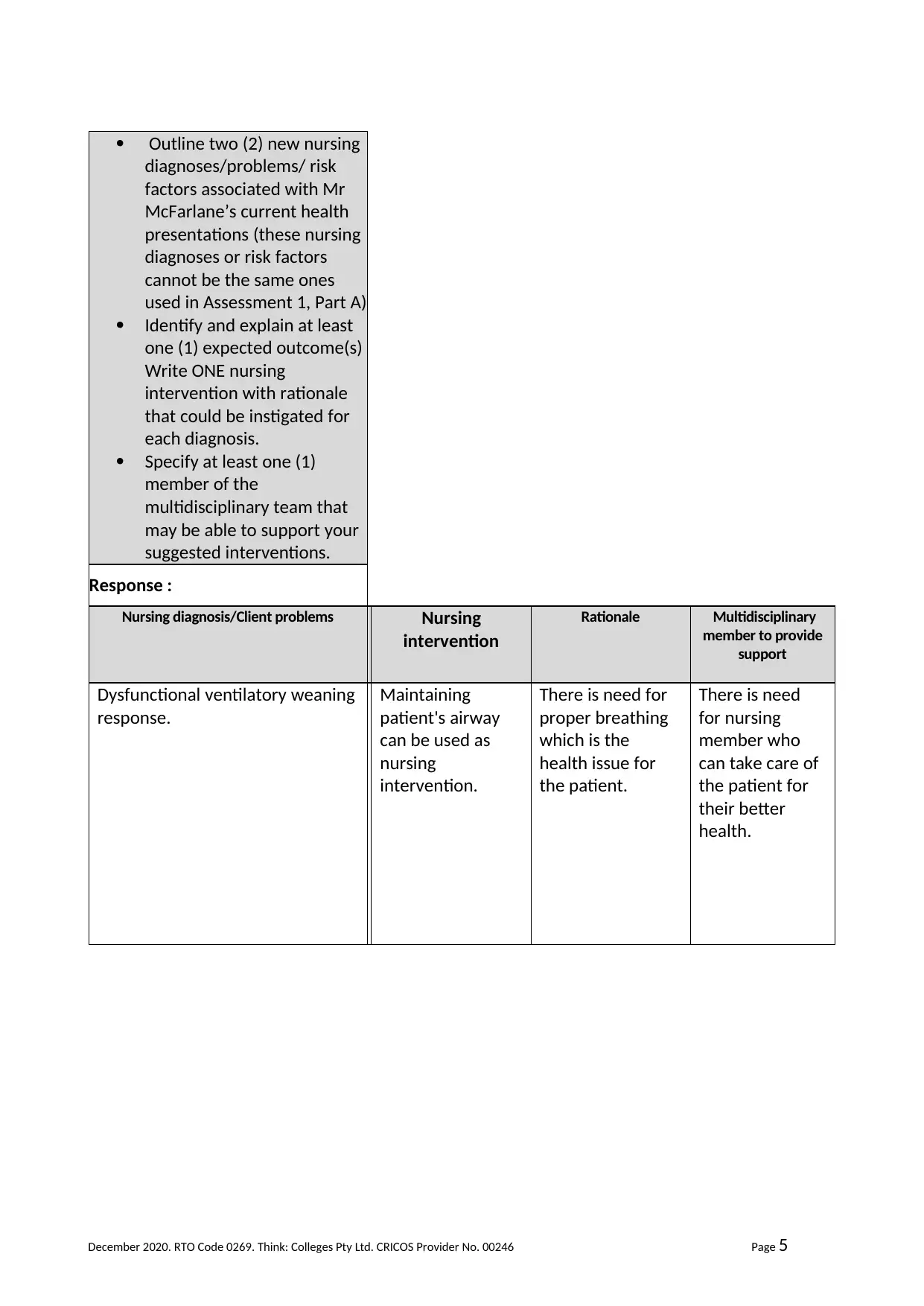
Outline two (2) new nursing
diagnoses/problems/ risk
factors associated with Mr
McFarlane’s current health
presentations (these nursing
diagnoses or risk factors
cannot be the same ones
used in Assessment 1, Part A)
Identify and explain at least
one (1) expected outcome(s)
Write ONE nursing
intervention with rationale
that could be instigated for
each diagnosis.
Specify at least one (1)
member of the
multidisciplinary team that
may be able to support your
suggested interventions.
Response :
Nursing diagnosis/Client problems Nursing
intervention
Rationale Multidisciplinary
member to provide
support
Dysfunctional ventilatory weaning
response.
Maintaining
patient's airway
can be used as
nursing
intervention.
There is need for
proper breathing
which is the
health issue for
the patient.
There is need
for nursing
member who
can take care of
the patient for
their better
health.
December 2020. RTO Code 0269. Think: Colleges Pty Ltd. CRICOS Provider No. 00246 Page 5
diagnoses/problems/ risk
factors associated with Mr
McFarlane’s current health
presentations (these nursing
diagnoses or risk factors
cannot be the same ones
used in Assessment 1, Part A)
Identify and explain at least
one (1) expected outcome(s)
Write ONE nursing
intervention with rationale
that could be instigated for
each diagnosis.
Specify at least one (1)
member of the
multidisciplinary team that
may be able to support your
suggested interventions.
Response :
Nursing diagnosis/Client problems Nursing
intervention
Rationale Multidisciplinary
member to provide
support
Dysfunctional ventilatory weaning
response.
Maintaining
patient's airway
can be used as
nursing
intervention.
There is need for
proper breathing
which is the
health issue for
the patient.
There is need
for nursing
member who
can take care of
the patient for
their better
health.
December 2020. RTO Code 0269. Think: Colleges Pty Ltd. CRICOS Provider No. 00246 Page 5
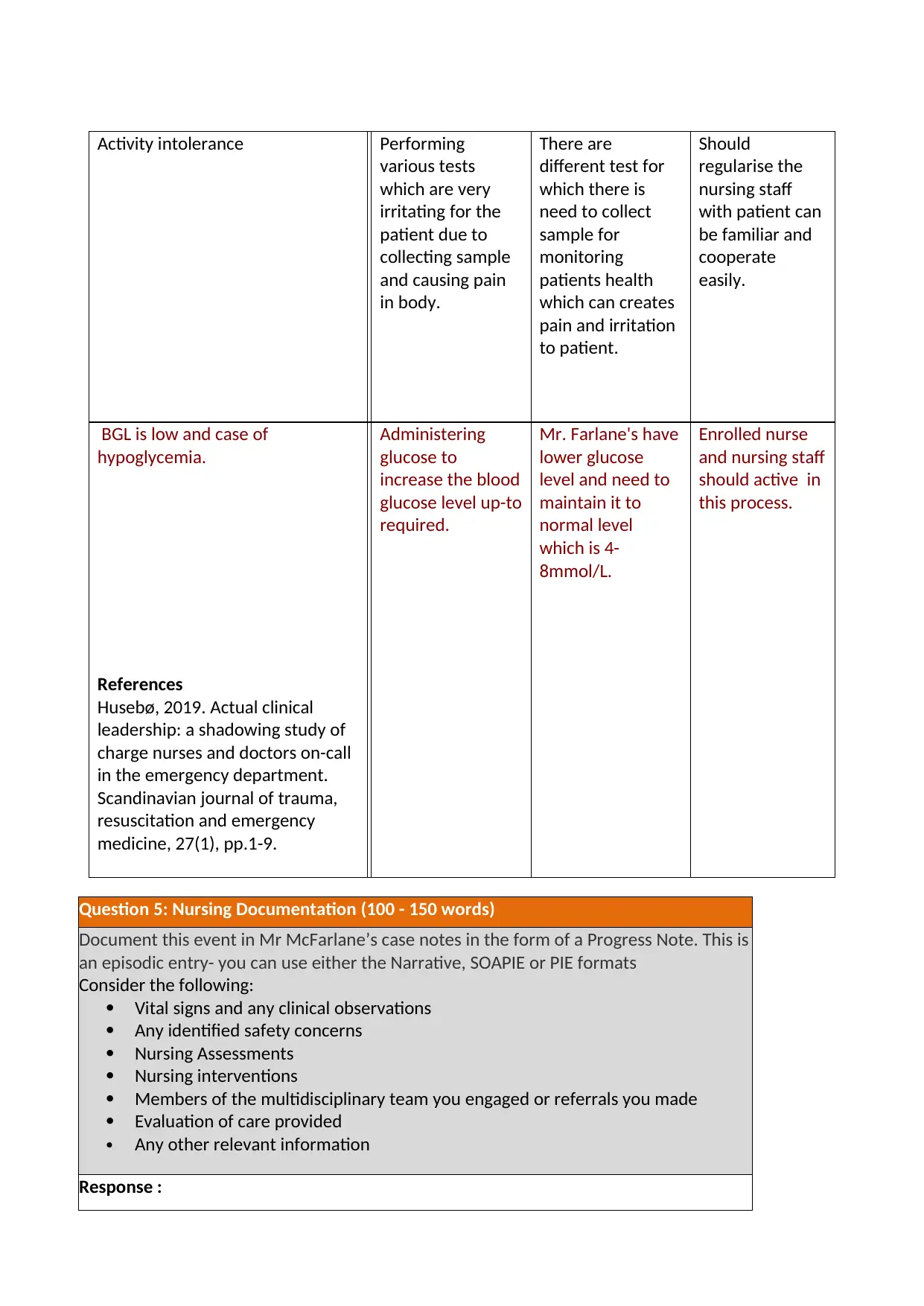
Activity intolerance Performing
various tests
which are very
irritating for the
patient due to
collecting sample
and causing pain
in body.
There are
different test for
which there is
need to collect
sample for
monitoring
patients health
which can creates
pain and irritation
to patient.
Should
regularise the
nursing staff
with patient can
be familiar and
cooperate
easily.
BGL is low and case of
hypoglycemia.
References
Husebø, 2019. Actual clinical
leadership: a shadowing study of
charge nurses and doctors on-call
in the emergency department.
Scandinavian journal of trauma,
resuscitation and emergency
medicine, 27(1), pp.1-9.
Administering
glucose to
increase the blood
glucose level up-to
required.
Mr. Farlane's have
lower glucose
level and need to
maintain it to
normal level
which is 4-
8mmol/L.
Enrolled nurse
and nursing staff
should active in
this process.
Question 5: Nursing Documentation (100 - 150 words)
Document this event in Mr McFarlane’s case notes in the form of a Progress Note. This is
an episodic entry- you can use either the Narrative, SOAPIE or PIE formats
Consider the following:
Vital signs and any clinical observations
Any identified safety concerns
Nursing Assessments
Nursing interventions
Members of the multidisciplinary team you engaged or referrals you made
Evaluation of care provided
Any other relevant information
Response :
various tests
which are very
irritating for the
patient due to
collecting sample
and causing pain
in body.
There are
different test for
which there is
need to collect
sample for
monitoring
patients health
which can creates
pain and irritation
to patient.
Should
regularise the
nursing staff
with patient can
be familiar and
cooperate
easily.
BGL is low and case of
hypoglycemia.
References
Husebø, 2019. Actual clinical
leadership: a shadowing study of
charge nurses and doctors on-call
in the emergency department.
Scandinavian journal of trauma,
resuscitation and emergency
medicine, 27(1), pp.1-9.
Administering
glucose to
increase the blood
glucose level up-to
required.
Mr. Farlane's have
lower glucose
level and need to
maintain it to
normal level
which is 4-
8mmol/L.
Enrolled nurse
and nursing staff
should active in
this process.
Question 5: Nursing Documentation (100 - 150 words)
Document this event in Mr McFarlane’s case notes in the form of a Progress Note. This is
an episodic entry- you can use either the Narrative, SOAPIE or PIE formats
Consider the following:
Vital signs and any clinical observations
Any identified safety concerns
Nursing Assessments
Nursing interventions
Members of the multidisciplinary team you engaged or referrals you made
Evaluation of care provided
Any other relevant information
Response :
⊘ This is a preview!⊘
Do you want full access?
Subscribe today to unlock all pages.

Trusted by 1+ million students worldwide
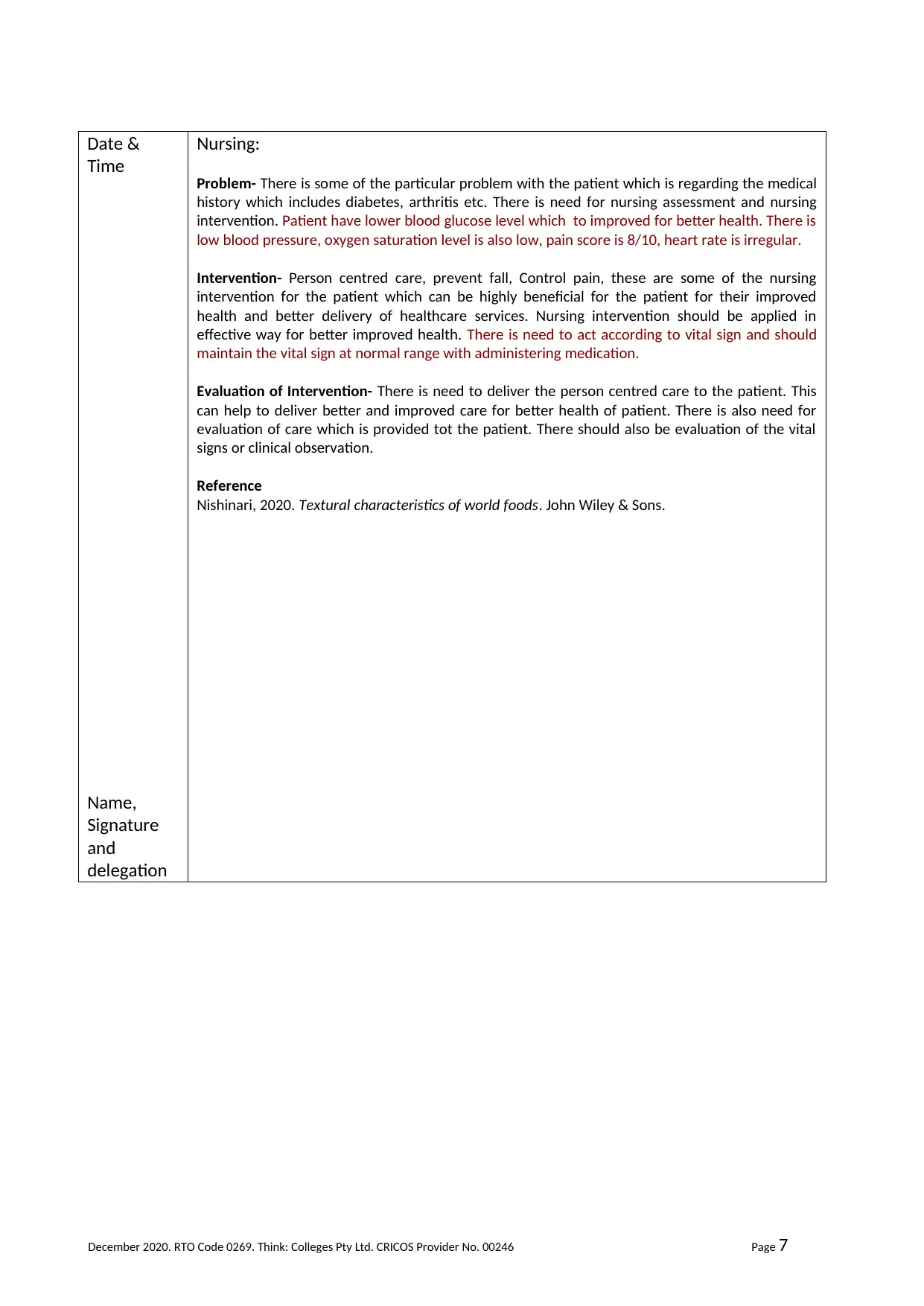
Date &
Time
Name,
Signature
and
delegation
Nursing:
Problem- There is some of the particular problem with the patient which is regarding the medical
history which includes diabetes, arthritis etc. There is need for nursing assessment and nursing
intervention. Patient have lower blood glucose level which to improved for better health. There is
low blood pressure, oxygen saturation level is also low, pain score is 8/10, heart rate is irregular.
Intervention- Person centred care, prevent fall, Control pain, these are some of the nursing
intervention for the patient which can be highly beneficial for the patient for their improved
health and better delivery of healthcare services. Nursing intervention should be applied in
effective way for better improved health. There is need to act according to vital sign and should
maintain the vital sign at normal range with administering medication.
Evaluation of Intervention- There is need to deliver the person centred care to the patient. This
can help to deliver better and improved care for better health of patient. There is also need for
evaluation of care which is provided tot the patient. There should also be evaluation of the vital
signs or clinical observation.
Reference
Nishinari, 2020. Textural characteristics of world foods. John Wiley & Sons.
December 2020. RTO Code 0269. Think: Colleges Pty Ltd. CRICOS Provider No. 00246 Page 7
Time
Name,
Signature
and
delegation
Nursing:
Problem- There is some of the particular problem with the patient which is regarding the medical
history which includes diabetes, arthritis etc. There is need for nursing assessment and nursing
intervention. Patient have lower blood glucose level which to improved for better health. There is
low blood pressure, oxygen saturation level is also low, pain score is 8/10, heart rate is irregular.
Intervention- Person centred care, prevent fall, Control pain, these are some of the nursing
intervention for the patient which can be highly beneficial for the patient for their improved
health and better delivery of healthcare services. Nursing intervention should be applied in
effective way for better improved health. There is need to act according to vital sign and should
maintain the vital sign at normal range with administering medication.
Evaluation of Intervention- There is need to deliver the person centred care to the patient. This
can help to deliver better and improved care for better health of patient. There is also need for
evaluation of care which is provided tot the patient. There should also be evaluation of the vital
signs or clinical observation.
Reference
Nishinari, 2020. Textural characteristics of world foods. John Wiley & Sons.
December 2020. RTO Code 0269. Think: Colleges Pty Ltd. CRICOS Provider No. 00246 Page 7
Paraphrase This Document
Need a fresh take? Get an instant paraphrase of this document with our AI Paraphraser
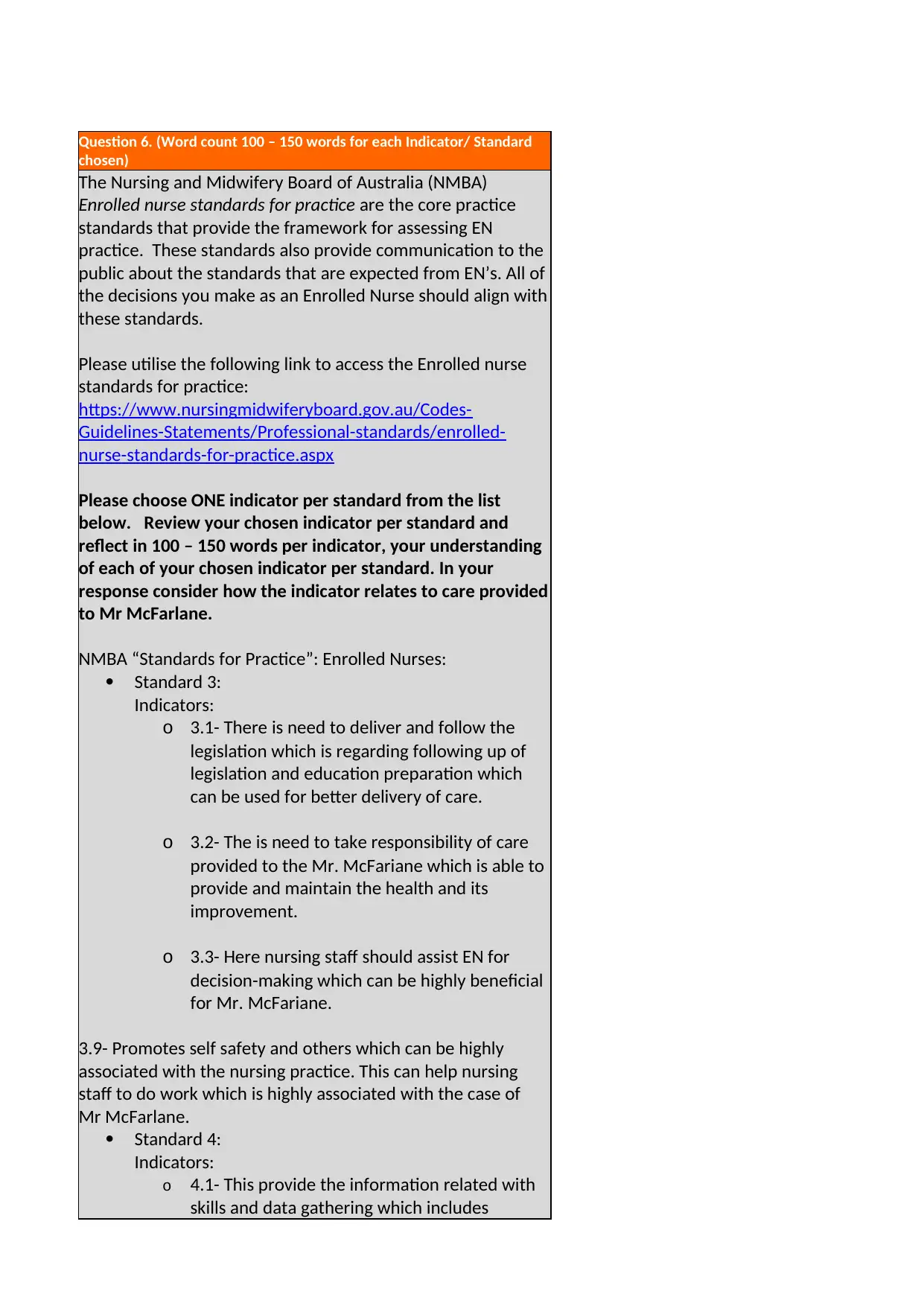
Question 6. (Word count 100 – 150 words for each Indicator/ Standard
chosen)
The Nursing and Midwifery Board of Australia (NMBA)
Enrolled nurse standards for practice are the core practice
standards that provide the framework for assessing EN
practice. These standards also provide communication to the
public about the standards that are expected from EN’s. All of
the decisions you make as an Enrolled Nurse should align with
these standards.
Please utilise the following link to access the Enrolled nurse
standards for practice:
https://www.nursingmidwiferyboard.gov.au/Codes-
Guidelines-Statements/Professional-standards/enrolled-
nurse-standards-for-practice.aspx
Please choose ONE indicator per standard from the list
below. Review your chosen indicator per standard and
reflect in 100 – 150 words per indicator, your understanding
of each of your chosen indicator per standard. In your
response consider how the indicator relates to care provided
to Mr McFarlane.
NMBA “Standards for Practice”: Enrolled Nurses:
Standard 3:
Indicators:
o 3.1- There is need to deliver and follow the
legislation which is regarding following up of
legislation and education preparation which
can be used for better delivery of care.
o 3.2- The is need to take responsibility of care
provided to the Mr. McFariane which is able to
provide and maintain the health and its
improvement.
o 3.3- Here nursing staff should assist EN for
decision-making which can be highly beneficial
for Mr. McFariane.
3.9- Promotes self safety and others which can be highly
associated with the nursing practice. This can help nursing
staff to do work which is highly associated with the case of
Mr McFarlane.
Standard 4:
Indicators:
o 4.1- This provide the information related with
skills and data gathering which includes
chosen)
The Nursing and Midwifery Board of Australia (NMBA)
Enrolled nurse standards for practice are the core practice
standards that provide the framework for assessing EN
practice. These standards also provide communication to the
public about the standards that are expected from EN’s. All of
the decisions you make as an Enrolled Nurse should align with
these standards.
Please utilise the following link to access the Enrolled nurse
standards for practice:
https://www.nursingmidwiferyboard.gov.au/Codes-
Guidelines-Statements/Professional-standards/enrolled-
nurse-standards-for-practice.aspx
Please choose ONE indicator per standard from the list
below. Review your chosen indicator per standard and
reflect in 100 – 150 words per indicator, your understanding
of each of your chosen indicator per standard. In your
response consider how the indicator relates to care provided
to Mr McFarlane.
NMBA “Standards for Practice”: Enrolled Nurses:
Standard 3:
Indicators:
o 3.1- There is need to deliver and follow the
legislation which is regarding following up of
legislation and education preparation which
can be used for better delivery of care.
o 3.2- The is need to take responsibility of care
provided to the Mr. McFariane which is able to
provide and maintain the health and its
improvement.
o 3.3- Here nursing staff should assist EN for
decision-making which can be highly beneficial
for Mr. McFariane.
3.9- Promotes self safety and others which can be highly
associated with the nursing practice. This can help nursing
staff to do work which is highly associated with the case of
Mr McFarlane.
Standard 4:
Indicators:
o 4.1- This provide the information related with
skills and data gathering which includes
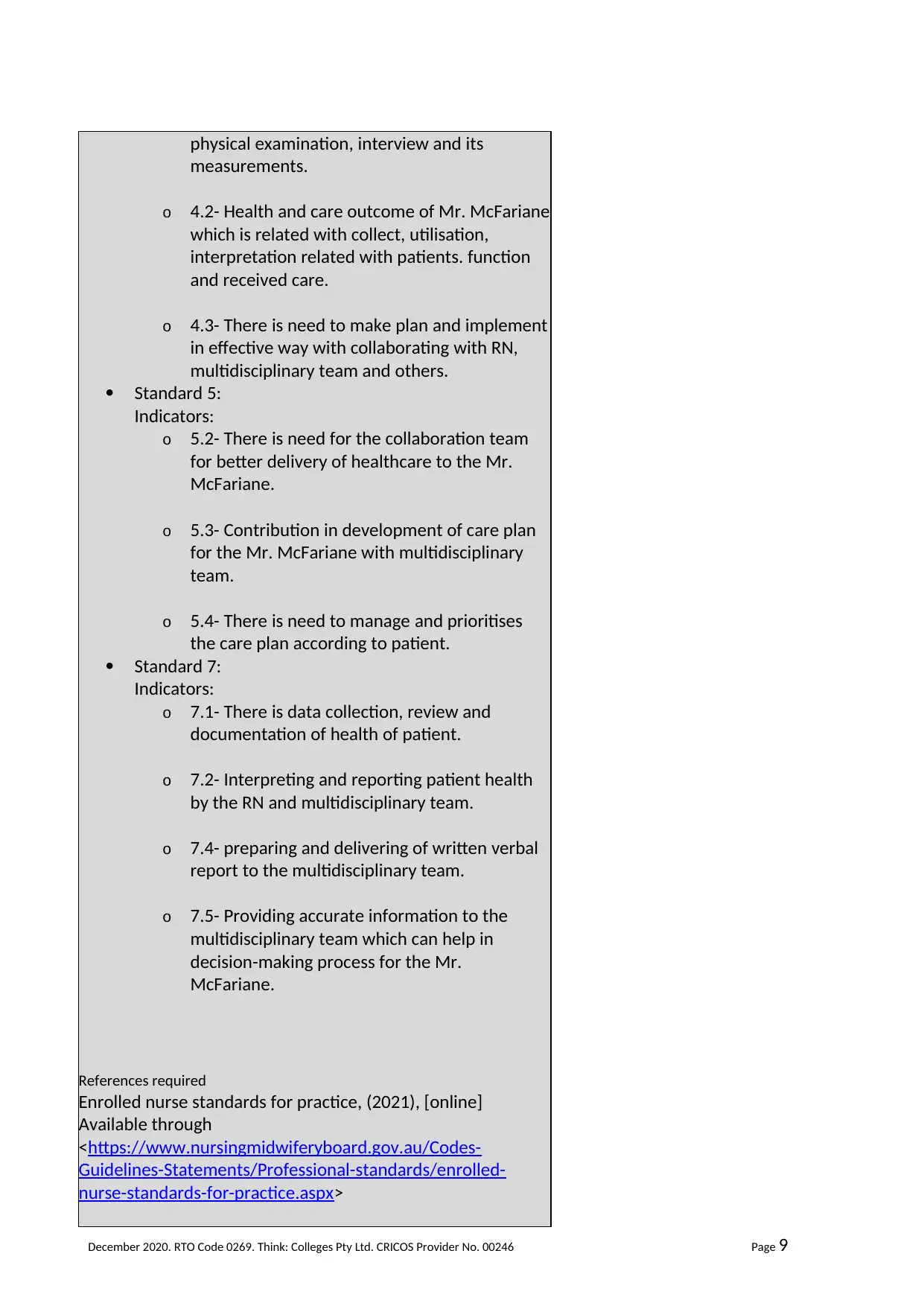
physical examination, interview and its
measurements.
o 4.2- Health and care outcome of Mr. McFariane
which is related with collect, utilisation,
interpretation related with patients. function
and received care.
o 4.3- There is need to make plan and implement
in effective way with collaborating with RN,
multidisciplinary team and others.
Standard 5:
Indicators:
o 5.2- There is need for the collaboration team
for better delivery of healthcare to the Mr.
McFariane.
o 5.3- Contribution in development of care plan
for the Mr. McFariane with multidisciplinary
team.
o 5.4- There is need to manage and prioritises
the care plan according to patient.
Standard 7:
Indicators:
o 7.1- There is data collection, review and
documentation of health of patient.
o 7.2- Interpreting and reporting patient health
by the RN and multidisciplinary team.
o 7.4- preparing and delivering of written verbal
report to the multidisciplinary team.
o 7.5- Providing accurate information to the
multidisciplinary team which can help in
decision-making process for the Mr.
McFariane.
References required
Enrolled nurse standards for practice, (2021), [online]
Available through
<https://www.nursingmidwiferyboard.gov.au/Codes-
Guidelines-Statements/Professional-standards/enrolled-
nurse-standards-for-practice.aspx>
December 2020. RTO Code 0269. Think: Colleges Pty Ltd. CRICOS Provider No. 00246 Page 9
measurements.
o 4.2- Health and care outcome of Mr. McFariane
which is related with collect, utilisation,
interpretation related with patients. function
and received care.
o 4.3- There is need to make plan and implement
in effective way with collaborating with RN,
multidisciplinary team and others.
Standard 5:
Indicators:
o 5.2- There is need for the collaboration team
for better delivery of healthcare to the Mr.
McFariane.
o 5.3- Contribution in development of care plan
for the Mr. McFariane with multidisciplinary
team.
o 5.4- There is need to manage and prioritises
the care plan according to patient.
Standard 7:
Indicators:
o 7.1- There is data collection, review and
documentation of health of patient.
o 7.2- Interpreting and reporting patient health
by the RN and multidisciplinary team.
o 7.4- preparing and delivering of written verbal
report to the multidisciplinary team.
o 7.5- Providing accurate information to the
multidisciplinary team which can help in
decision-making process for the Mr.
McFariane.
References required
Enrolled nurse standards for practice, (2021), [online]
Available through
<https://www.nursingmidwiferyboard.gov.au/Codes-
Guidelines-Statements/Professional-standards/enrolled-
nurse-standards-for-practice.aspx>
December 2020. RTO Code 0269. Think: Colleges Pty Ltd. CRICOS Provider No. 00246 Page 9
⊘ This is a preview!⊘
Do you want full access?
Subscribe today to unlock all pages.

Trusted by 1+ million students worldwide
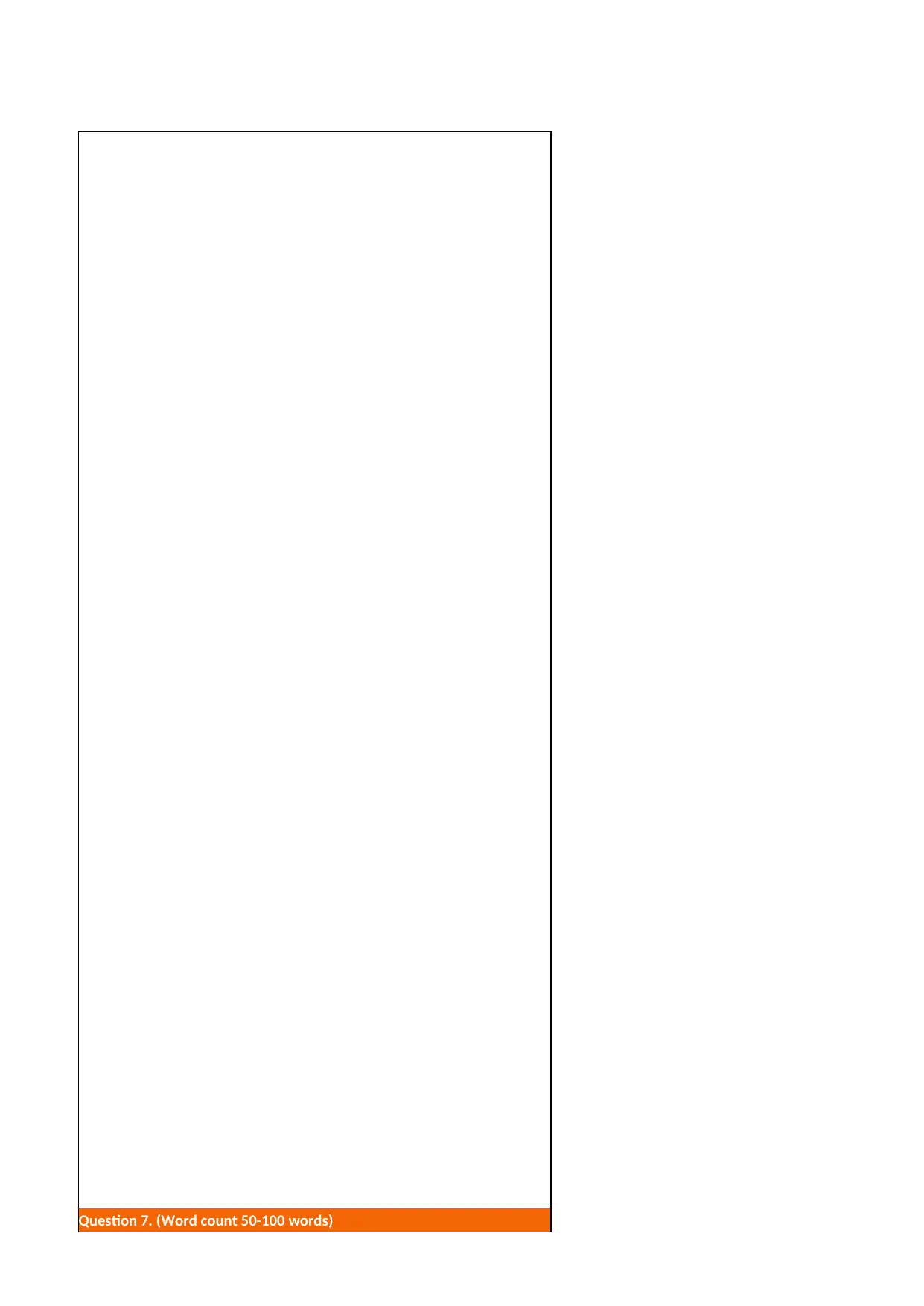
Question 7. (Word count 50-100 words)
Paraphrase This Document
Need a fresh take? Get an instant paraphrase of this document with our AI Paraphraser
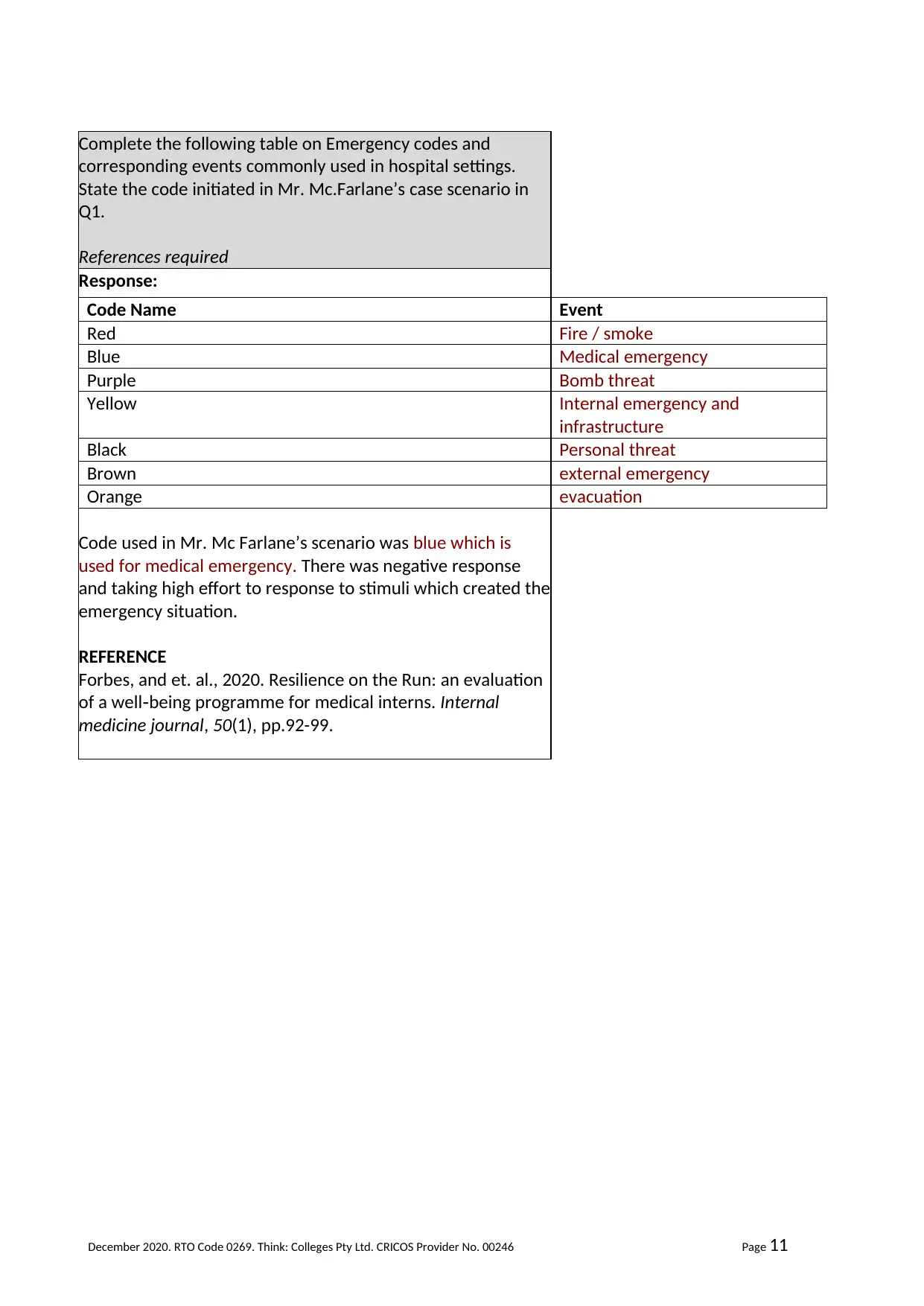
Complete the following table on Emergency codes and
corresponding events commonly used in hospital settings.
State the code initiated in Mr. Mc.Farlane’s case scenario in
Q1.
References required
Response:
Code Name Event
Red Fire / smoke
Blue Medical emergency
Purple Bomb threat
Yellow Internal emergency and
infrastructure
Black Personal threat
Brown external emergency
Orange evacuation
Code used in Mr. Mc Farlane’s scenario was blue which is
used for medical emergency. There was negative response
and taking high effort to response to stimuli which created the
emergency situation.
REFERENCE
Forbes, and et. al., 2020. Resilience on the Run: an evaluation
of a well being programme for medical interns.‐ Internal
medicine journal, 50(1), pp.92-99.
December 2020. RTO Code 0269. Think: Colleges Pty Ltd. CRICOS Provider No. 00246 Page 11
corresponding events commonly used in hospital settings.
State the code initiated in Mr. Mc.Farlane’s case scenario in
Q1.
References required
Response:
Code Name Event
Red Fire / smoke
Blue Medical emergency
Purple Bomb threat
Yellow Internal emergency and
infrastructure
Black Personal threat
Brown external emergency
Orange evacuation
Code used in Mr. Mc Farlane’s scenario was blue which is
used for medical emergency. There was negative response
and taking high effort to response to stimuli which created the
emergency situation.
REFERENCE
Forbes, and et. al., 2020. Resilience on the Run: an evaluation
of a well being programme for medical interns.‐ Internal
medicine journal, 50(1), pp.92-99.
December 2020. RTO Code 0269. Think: Colleges Pty Ltd. CRICOS Provider No. 00246 Page 11
1 out of 11
Related Documents
Your All-in-One AI-Powered Toolkit for Academic Success.
+13062052269
info@desklib.com
Available 24*7 on WhatsApp / Email
![[object Object]](/_next/static/media/star-bottom.7253800d.svg)
Unlock your academic potential
Copyright © 2020–2026 A2Z Services. All Rights Reserved. Developed and managed by ZUCOL.





